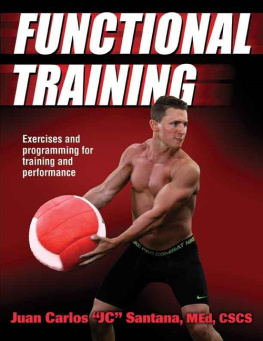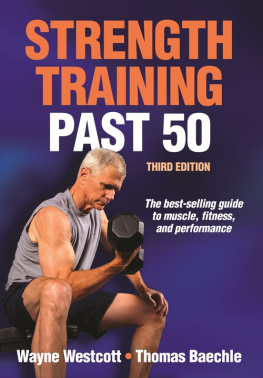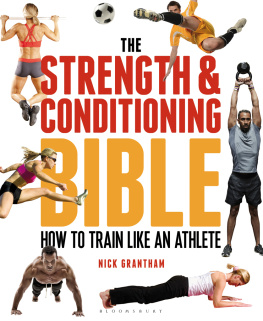Thanks to Bill Laich, M.D., Ph.D., Director of Sports Sciences at the CRAFT Medical Research Center in Reseda, California, for his invaluable input on the biochemistry of sports training. I've had the pleasure of working with some truly great athletes. This book is dedicated to them:
Lyle Alzado, L.A. Raiders
Jim Byrne, L.A. Rams
Sid Fernandez, N.Y. Mets
Mark Gastineau, N.Y. Jets
1-STRENGTH TRAINING: A Fresh Look at an Age-Old Topic
Where people of strength gather, their discussion inevitably turns to the methods of training that gave them the greatest returns in strength development. The topic of strength training, therefore, has been bantered about in gyms since gyms were invented. The importance of strength is elemental to anyone's training goals, be they for sports in general, fitness, bodybuilding, or the greatest strength sport of all, powerlifting. So, I implore you to read on. Discover the wherewithal to exceed the record feats of strength of our predecessors. Discover what it will take to achieve massive strength and explosiveness.
WHERE DOES OUR STRENGTH COME FROM?
I have identified no fewer than 23 different sources of strength (see page 2). And the most amazing fact is that only two of these factors are genetically predetermined, meaning that you can do little to augment them. Conversely, you can augment or in some way positively modify the other 21.
Let me give you a brief description of the most significant factors contributing to strength. Then I'll lay a definition of strength on you that'll be sure to turn your head. Together with knowing the sources of strength, knowing what strength really is will give you the knowledge to carry your training light years beyond what you've ever dreamed possible. Certainly far enough to eclipse the records of the great athletes of the past.
FACTORS AFFECTING STRENGTH Anatomical Physiological Factors
Muscle fiber arrangement (fusiform, uni-, bi-, and multipennate)
Musculoskeletal leverage
Ratio of fast-vs. slow-twitch muscle fibers
Tissue leverage (interstitial and intracellular leverage stemming from fat deposits, sarcoplasmic content satellite cell proliferation and fluid)
Freedom of movement between fibers and muscles (scar tissue and adhesions can limit strength)
Tissue viscoelasticity
Stretch reflex (muscle spindles)
Sensitivity of the Golgi tendon organ *
Endocrine (hormonal levels/functioning)
Energy transfer systems' efficiency
Extent of hyperplasia (muscle splitting)
Proliferation and growth of myofibrils
Intramuscular/intracellar friction
Motor unit recruitment*
Psychoneural/learned Response Factors
"Psych" (arousal level)
Pain tolerance
"Focus" (concentration)
Social learning (learned inhibitory responses limit strength)
"Skill" coordination (activation/inhibition of prime movers, synergists, and stabilizers in an efficient sequence; also, position, sequence, direction timing, speed, and effect of force application)
External/Environmental Factors
Equipment (use of the "best")
Environment (heat cold, humidity, precipitation, wind, altitude)
Gravity
Opposing and assistive forces (e.g., opponent's efforts)
*May have components logically suited to the Psychoneural/Learned factors category.

Muscle Fiber Arrangement . Muscles are an arrangement of muscle cells-called muscle fibers. These fibers can be arranged in unipennate, bipennate, or multipennate configurations. Typically, unipennate muscles (such as the biceps) are adapted for large amplitude movements, and aren't suited for strength, but instead are adapted to speed. Other muscles, such as the psoas muscle (the same muscle tissue as in filet mignon steaks) are arrangements of very short cells in a tweedlike pattern, and are extremely suited to strength, although their movement range at the joint is somewhat limited. Knowing this may assist in improving the efficiency of training speed versus strength movements in some sports, but since there's little you can do about the actual arrangement (it's genetically predetermined), it's traditionally been an overlooked factor by strength athletes in general.
Musculoskeletal Leverage . Your musculoskeletal system is an arrangement of levers, typically of the third class. This means that the fulcrum-the joint-is at one end, the source of force is in the middle, and the resistance is at the other end. This arrangement is suited for fast movements. The farther away Mother Natures places the source of force (tendon insertion) the stronger youll be. As with muscle fiber arrangement, leverage is a factor which you have no control over, saved improved skills mechanics in your respective sports endeavors. Improving your skills mechanics will have the net effect of improving your overall body movements, thereby taking advantage of your inherent strengths while minimizing the detrimental effects of your weaknesses. All wise coaches know this, and that's what practice is all about. For any athlete, the same approach should predominate all weight training movements in an attempt to impart maximum constructive overload to the muscles for greater growth.
 Tissue Leverage . Called interstitial leverage, mechanical advantages are gained if theres intramuscular fat and fluid filling the spaces between and inside the muscle cells. Care should be taken, though, because such a practice can lead to that "puffy" look that's sure to knock you out of contention in bodybuilding contests. For strength athletes, such as super-heavyweight powerlifters (where sheer mass may be advantageous), it's wise to seek a bit of such leverage provided it isn't carried to an extreme, thereby disrupting your strength-to-weight ratio. For most other athletes, attempts to improve tissue leverage yield no sports advantages.
Tissue Leverage . Called interstitial leverage, mechanical advantages are gained if theres intramuscular fat and fluid filling the spaces between and inside the muscle cells. Care should be taken, though, because such a practice can lead to that "puffy" look that's sure to knock you out of contention in bodybuilding contests. For strength athletes, such as super-heavyweight powerlifters (where sheer mass may be advantageous), it's wise to seek a bit of such leverage provided it isn't carried to an extreme, thereby disrupting your strength-to-weight ratio. For most other athletes, attempts to improve tissue leverage yield no sports advantages.
Enzyme Concentrations . The enzymes that direct the activity of your muscle cells can be in balances amenable to explosive, strong contracture or for endurance activities. Training specifically for power or for endurance is the stimulus for altering this delicate balance.











 Tissue Leverage . Called interstitial leverage, mechanical advantages are gained if theres intramuscular fat and fluid filling the spaces between and inside the muscle cells. Care should be taken, though, because such a practice can lead to that "puffy" look that's sure to knock you out of contention in bodybuilding contests. For strength athletes, such as super-heavyweight powerlifters (where sheer mass may be advantageous), it's wise to seek a bit of such leverage provided it isn't carried to an extreme, thereby disrupting your strength-to-weight ratio. For most other athletes, attempts to improve tissue leverage yield no sports advantages.
Tissue Leverage . Called interstitial leverage, mechanical advantages are gained if theres intramuscular fat and fluid filling the spaces between and inside the muscle cells. Care should be taken, though, because such a practice can lead to that "puffy" look that's sure to knock you out of contention in bodybuilding contests. For strength athletes, such as super-heavyweight powerlifters (where sheer mass may be advantageous), it's wise to seek a bit of such leverage provided it isn't carried to an extreme, thereby disrupting your strength-to-weight ratio. For most other athletes, attempts to improve tissue leverage yield no sports advantages.